全文HTML
--> --> -->Si是GaN最常见的n型掺杂剂, 但是在外延层中出现显著的拉伸应变导致Si掺杂GaN的总缺陷密度增加. 最近, 几个研究小组发现, 使用锗(Ge)代替Si作为n型掺杂剂可能有助于解决该问题, 因为由于Ge和Ga原子具有相似的离子半径, Ge替换Ga点位所引起的晶格畸变会较小[10,11]. Ge也是一种浅施主, 其激活能约为20 meV, 与Si(17 meV)相似[12,13]. Ge可作为GaN中非常有利的n型掺杂剂, 它将使GaN的表面更平滑, 膜应力更低, 缺陷更少[14,15]. 因此, 对Ge掺杂GaN(GaN: Ge)晶体缺陷态的载流子动力学研究尤为必要.
GaN中缺陷引起的载流子动力学除了与缺陷本身有关, 还和载流子的产生方式有关. 利用单光子吸收和双光子吸收都可以产生载流子, 这两种方式不仅可以改变光生载流子的浓度还可以控制非平衡载流子的分布. 在单光子激发下(one-photon excitation, 1PE), 高吸收系数会在半导体表面区域产生极不均匀的光生载流子. 在这种情况下, 载流子扩散和表面复合等效应会导致GaN基发光二极管内部量子效率显著下降[16,17]. 而相反, 双光子激发(two-photon excitation, 2PE)会在半导体内部产生较均匀的光生载流子, 这可以有效地避免载流子扩散和表面复合效应, 更准确地获得缺陷引起的载流子复合弛豫等载流子动力学特性. 基于自由载流子吸收的时间分辨泵浦探测技术是探究GaN载流子动力学十分有效的方法[18]. 然而, 大部分瞬态吸收测量都只利用单波长进行探测[19-21]. 利用白光超连续谱(宽波段)作为探测光可以同时了解光生载流子的光谱和时间特性, 了解不同缺陷态之间载流子的弛豫复合机制和寿命, 给载流子动力学提供更丰富和准确的信息[22,23]. 最近, 利用飞秒瞬态吸收光谱, 成功区分了p型GaN中的表面复合和体缺陷俘获过程, 获得了相应的表面复合寿命和载流子俘获时间[24].
本文利用飞秒脉冲2PE下的近红外探测吸收光谱方法探究GaN: Ge的缺陷载流子动力学机制. 在近红外波段下宽带半导体中的载流子吸收会明显强于可见光波段下. 实验发现, 在n型GaN中, 载流子吸收随着探测波长增加而显著增强, 光学声子辅助的空穴间接吸收对载流子动力学起着决定性的作用. 瞬态吸收响应呈现双指数衰减, 其中较快的寿命τ1几乎不随激发能流发生变化, 而较慢的寿命τ2随着激发能流逐渐增大. 利用载流子复合模型可以很好地解释实验结果, 并且获得了相应缺陷态的载流子俘获系数.
本文利用瞬态吸收光谱(transient absorption spectroscopy, TAS)来探究GaN: Ge的超快载流子动力学, 进行了波长相关的瞬态吸收测量. 与时间分辨光致发光相比, TAS方法不受载流子复合方式的影响, 能够在不同光子能量探测下获得非平衡载流子浓度, 可以通过吸收谱线获得缺陷态的跃迁能级, 具体测量光路以及原理参见文献[25,26]. TAS的激发脉冲光源为Light Conversion公司掺镱光纤(Yb: KGW)飞秒激光器(PHAROS, 1030 nm)泵浦的光学参量放大器(OPA, Light Conversion ORPHEUS, 190 fs, 6 kHz), 激发光在样品处的光斑半径约为0.8 mm.500—1100 nm波长范围的白光超连续谱(white-light supercontinuum, WLS)探测脉冲由OPA泵浦脉冲(1030 nm)聚焦到5 mm非线性介质YAG晶体上而产生, 在样品处的光斑半径小于100 μm. 利用成像光谱仪结合Si二极管阵列光电探测器检测样品之后的透射探测脉冲信号. 在每个延迟时间对300个瞬态吸收光谱进行平均处理来消除泵浦光和光谱的浮动. 通过标准同步锁相放大器比较在有泵浦脉冲和无泵浦脉冲时的透过样品的WLS强度, 即可得到不同探测波长λp和延迟时间t下样品的差分光密度(?OD):
3.1.双光子激发下的瞬态吸收光谱
图1(a)显示了GaN: Ge晶体的线性吸收光谱, 当波长大于带隙对应的波长时(365 nm, 3.4 eV)时, 样品不存在任何光吸收, 证明了样品具有很高的纯度及极低的缺陷密度. 利用650 nm下的飞秒Z扫描测量技术来验证GaN: Ge晶体的双光子吸收特性. 光源与瞬态吸收光谱所用的光源一致, 在焦点处光斑的半径约为45 μm. 在不同入射脉冲能量下的开孔Z扫描曲线如图1(b)所示. 样品表现出明显的反饱和吸收, 样品的吸收系数变化Δα可表示为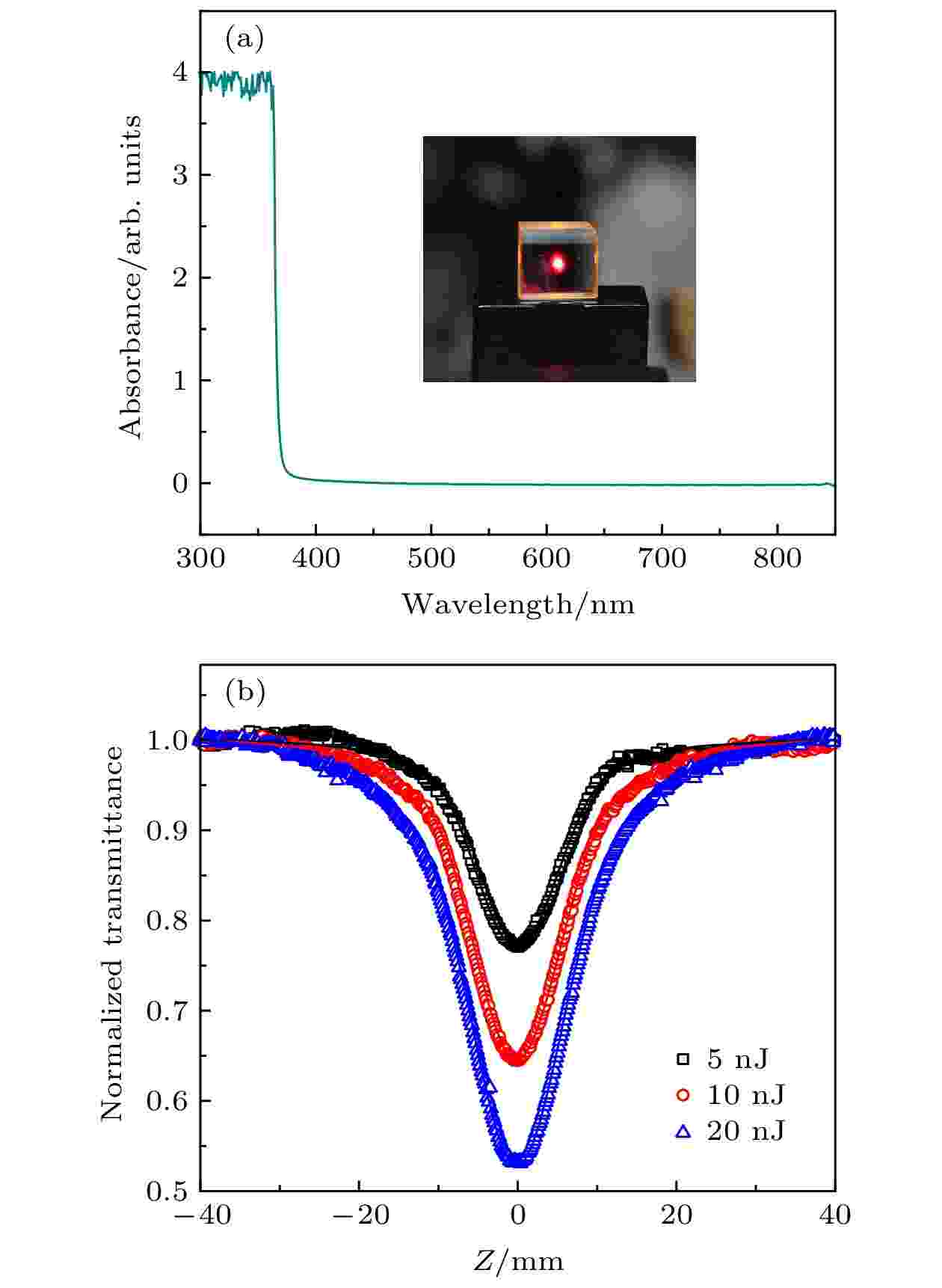 图 1 (a) GaN: Ge晶体的线性吸收谱, 内插图为2PE下的发光图片; (b)不同脉冲能量激发下GaN: Ge的开孔Z扫描曲线, 实线为理论拟合曲线
图 1 (a) GaN: Ge晶体的线性吸收谱, 内插图为2PE下的发光图片; (b)不同脉冲能量激发下GaN: Ge的开孔Z扫描曲线, 实线为理论拟合曲线Figure1. (a) Linear absorption spectrum of GaN: Ge crystal. The inset shows the two-photon excited photoluminescence photograph of sample; (b) open-aperture Z-scan data of GaN: Ge at several input pulse energies, the solid lines are theoretical fitting curves.
图2显示了2PE(650 nm)和1PE(325 nm)下GaN:Ge的TAS响应. 在不同的激发波长下, 整个吸收光谱(1.1—2.6 eV)都随着探测波长的增加单调增强, 这是自由载流子吸收才具备的特点[30,31]. 此外, 没有任何吸收峰的存在, 也证明可以忽略带内缺陷引起的光吸收. 据此, 瞬态吸收可认为由导带和价带内的电子和空穴间接吸收引起, 瞬态吸收响应的衰减对应着导带电子和价带空穴的复合. 但是与2PE下TAS响应不同的是, 1PE下的TAS响应几乎不随延迟时间衰减, 即使在特别低的激发能流下(0.1 mJ/cm2). 这是由于1PE下非平衡载流子浓度(约1018 cm–3)远大于样品中的缺陷浓度(约1016 cm–3), 缺陷对载流子弛豫的影响很小. 而2PE下的非平衡载流子浓度与缺陷浓度相近, 因此, 本文重点分析2PE下的TAS响应来研究缺陷对GaN: Ge超快载流子动力学的影响及机制. 利用关系

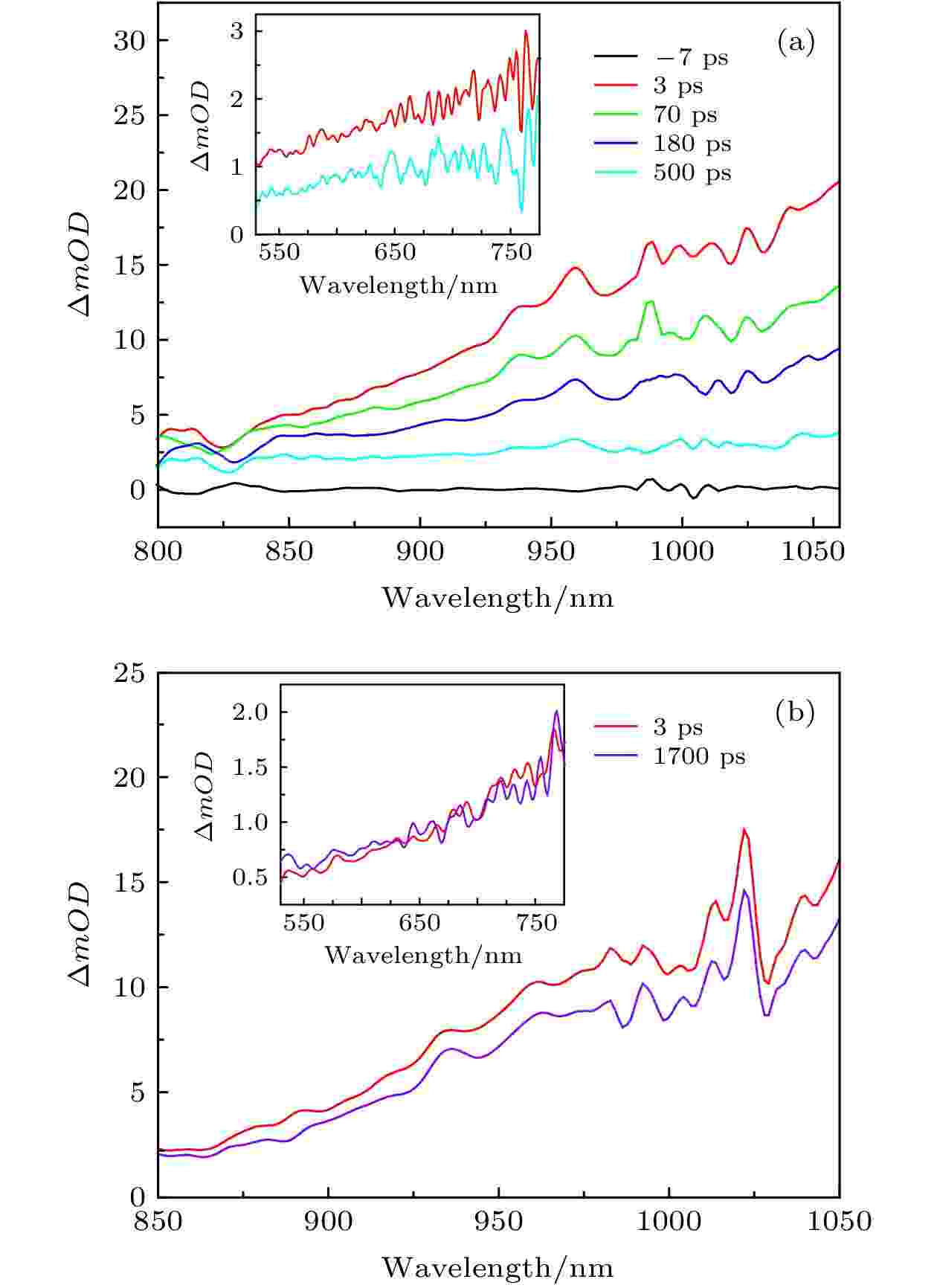 图 2 (a) 2PE下GaN: Ge的超快瞬态吸收光谱, 激发能流为0.8 mJ/cm2; (b) 1PE下GaN: Ge的超快瞬态吸收光谱, 激发能流为0.5 mJ/cm2. 内插图均为可见光探测下的结果
图 2 (a) 2PE下GaN: Ge的超快瞬态吸收光谱, 激发能流为0.8 mJ/cm2; (b) 1PE下GaN: Ge的超快瞬态吸收光谱, 激发能流为0.5 mJ/cm2. 内插图均为可见光探测下的结果Figure2. (a) Ultrafast TAS in GaN: Ge using 2PE under the excitation fluence of 0.8 mJ/cm2; (b) ultrafast TAS in GaN: Ge using 1PE under the excitation fluence of 0.5 mJ/cm2. The insets show the TAS probed at visible wavelengths.
2
3.2.超快载流子动力学
图3(a)显示了2PE不同激发能流下从TAS响应中提取的GaN: Ge在探测波长1050 nm下的瞬态吸收衰减响应. 为了看到更快的超快过程, 图3(a)中的内插图展示了短时间尺度下的瞬态吸收响应(0.8 mJ/cm2). 在零延迟附近超快的尖峰响应(0—0.4 ps)来源于泵浦光和探测光重合时产生的相干散射, 而在之后观察到吸收信号约1 ps的上升时间, 这可认为是非平衡载流子产生与弛豫到导带底部的过程(带内载流子弛豫过程). 在2—3 ps后吸收响应逐渐衰减, 利用双指数衰减方程可以很好地拟合实验结果: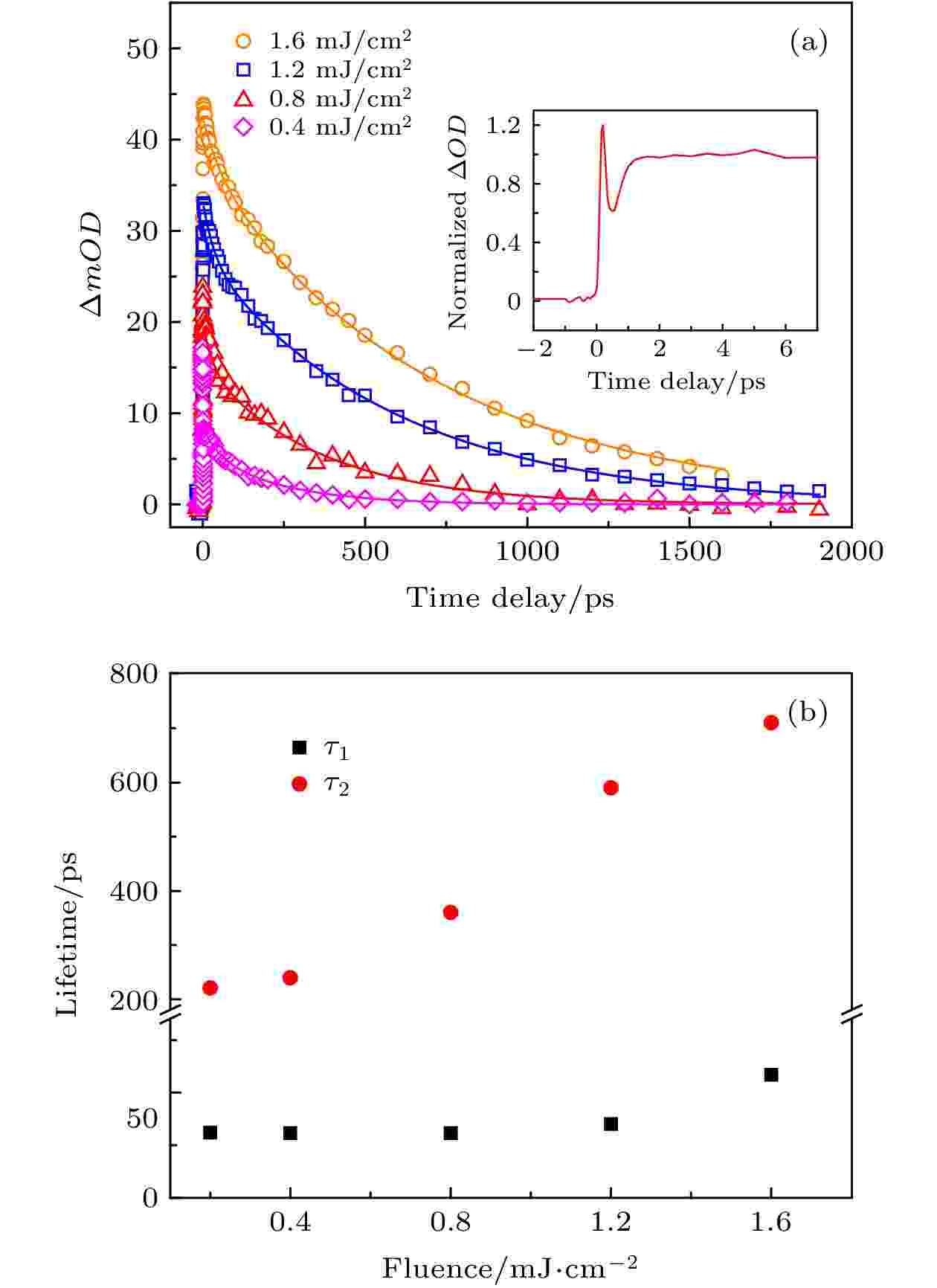 图 3 (a)不同激发能流下GaN: Ge的瞬态吸收动力学, 探测波长为1050 nm, 实线为双指数拟合曲线, 内插图为较短时间尺度下(7 ps)的数据; (b)不同激发能流下瞬态吸收衰减曲线拟合得到的快速和慢速弛豫寿命(分别为τ1和τ2)
图 3 (a)不同激发能流下GaN: Ge的瞬态吸收动力学, 探测波长为1050 nm, 实线为双指数拟合曲线, 内插图为较短时间尺度下(7 ps)的数据; (b)不同激发能流下瞬态吸收衰减曲线拟合得到的快速和慢速弛豫寿命(分别为τ1和τ2)Figure3. (a) The transient absorption kinetics in GaN: Ge under various excitation fluence probed at 1050 nm, the solid lines denote the theoretical curves using bi-exponential decay, and the inset illustrates the transient absorption kinetics in a 7 ps time window; (b) the fast and slow relaxation time (τ1 and τ2, respectively) extracted from transient absorption kinetics under various excitation fluence.
通常, 半导体中的载流子可以通过平衡方程模拟[18]:

2
3.3.载流子弛豫复合机制
为了进一步解释载流子动力学机制, 根据3.2节的分析, 基于图4所示的能级系统, 利用速率方程对载流子动力学进行模拟. 在图4中, Ge杂质产生的浅施主能级在室温下全部电离提供热平衡下的自由电子. 把样品中的缺陷能级分为两类: 1)辐射受主(-/0)能级CN, 其浓度为Ni, 该缺陷导致了缺陷发光(YL); 2)引起非辐射复合的线缺陷, 估计TDs引起的载流子寿命τnRad = 40 ns. 对于第一类情况: CN受主能级在价带上方约0.9 eV处[33,39], 在n型GaN中由于施主能级的存在(浓度为Nd), CN带一价负电(即CN—), 它可以以俘获系数Cpi俘获价带中产生的空穴, CN—变为CN0; 随后, 被俘获的空穴可以与导带中的电子以系数Cni发生复合, 发出光子(YL), CN0再转变为CN—. 此外, 我们也考虑了导带电子与价带空穴的直接复合, 通过复合速率BRad带间辐射复合产生BE.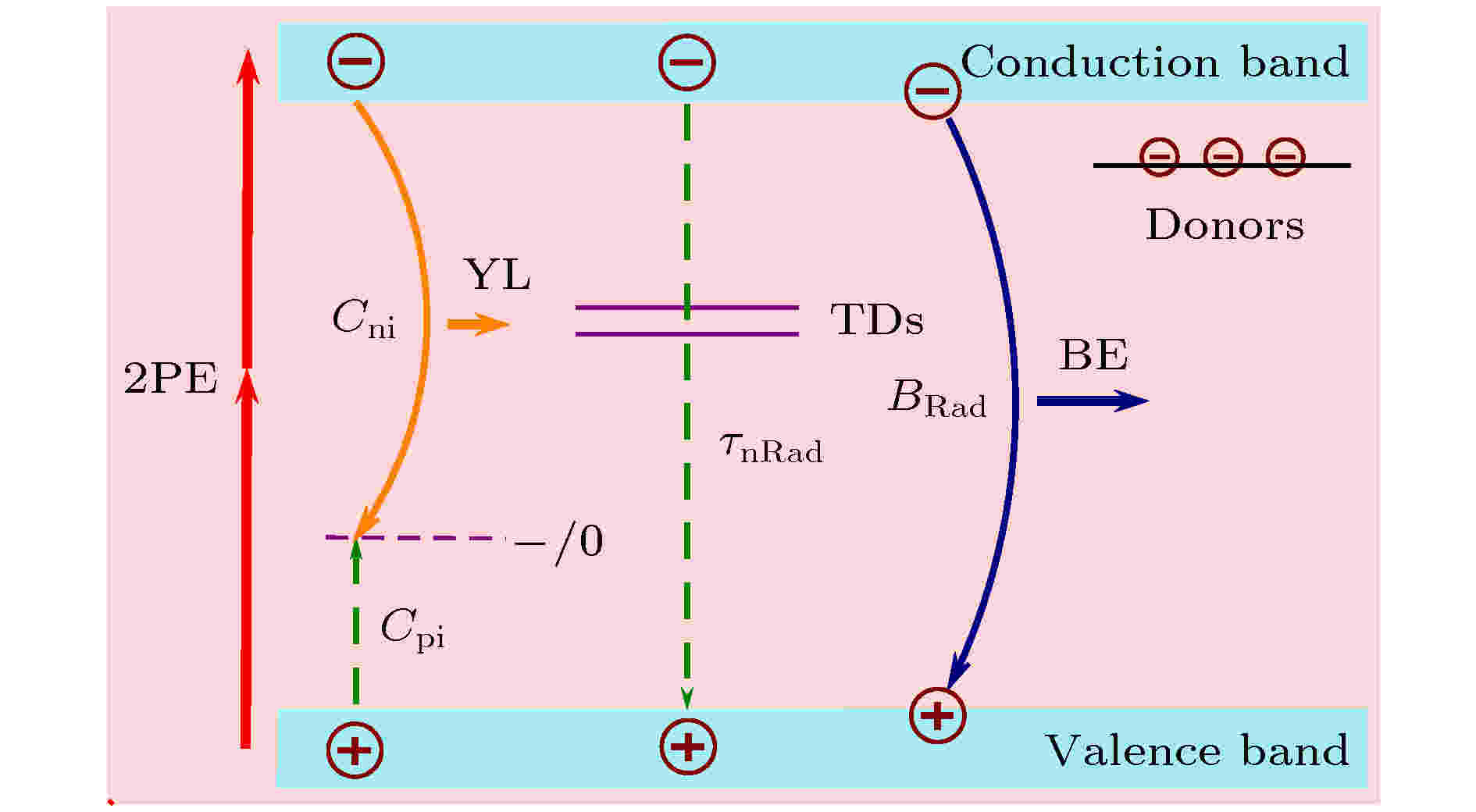 图 4 用于模拟2PE下GaN载流子动力学的能带示意图. 直虚线箭头表示无辐射跃迁, 向下曲线箭头表示通过辐射复合产生的发光
图 4 用于模拟2PE下GaN载流子动力学的能带示意图. 直虚线箭头表示无辐射跃迁, 向下曲线箭头表示通过辐射复合产生的发光Figure4. Energy band diagram used to model the carrier dynamics of GaN under 2PE. Straight broken arrows denote non-radiative transitions and curvy downwards arrows denote emissions via radiative recombination.
根据3.1节的分析, 随着探测波长的增加, 空穴吸收对载流子吸收的贡献逐渐增大. 由于(–/0)能级距离价带较近, 因此, 空穴俘获的速度将远快于导带电子的复合速度(Cpi > Cni), 这导致了图2(a)中瞬态吸收谱线的b值随着延迟时间逐渐降低. 当Δn < Ni时, 双光子激发产生的空穴都会被受主能级俘获; 当Δn > Ni时, CN0浓度产生饱和, CN—浓度降为零, 电子复合的速率将会制约空穴的俘获. 这也解释了为何当激发能流为0.8 mJ/cm2时载流子寿命显著增长, 并随着激发能流的提高而进一步增长(见图3(b)). 根据激发的载流子浓度, 可以估计Ni ≈ 0.5 × 1016—2 × 1016 cm–3, 这与SIMS测得C杂质浓度十分一致. 当然, GaN中还可能存在引起其他缺陷发光的受主能级和无辐射复合中心, 但是考虑到它们对空穴的俘获系数与Cpi都在10–7 cm3·s–1量级[7,8,34,39,40], 所以可以认为它们在样品中的浓度远小于1016 cm–3.
根据图4的示意图, 可以建立如下的速率方程:




| 参数 | 数值 |
| Ni | 1 × 1016 cm–3 |
| Cni | (2.7 ± 0.8) × 10–9 cm3·s–1 |
| Cpi | (5.9 ± 0.7) × 10–7 cm3·s–1 |
| τnRad | 40 ns |
| BRad | 3 × 10–11 cm3·s–1 |
| S | 7 ± 1 |
表1用于模拟实验结果使用和确定的参数. Ni和τnRad的数值为预估值, BRad数值来自参考文献[18], Cni, Cpi和S数值为拟合实验数据确定的参数
Table1.Parameters used/determined to model the experimental results. The values of Ni and τnRad were estimated. The value of BRad was extracted from Ref. [18]. The values of Cni, Cpi and S were determined by fitting the data.
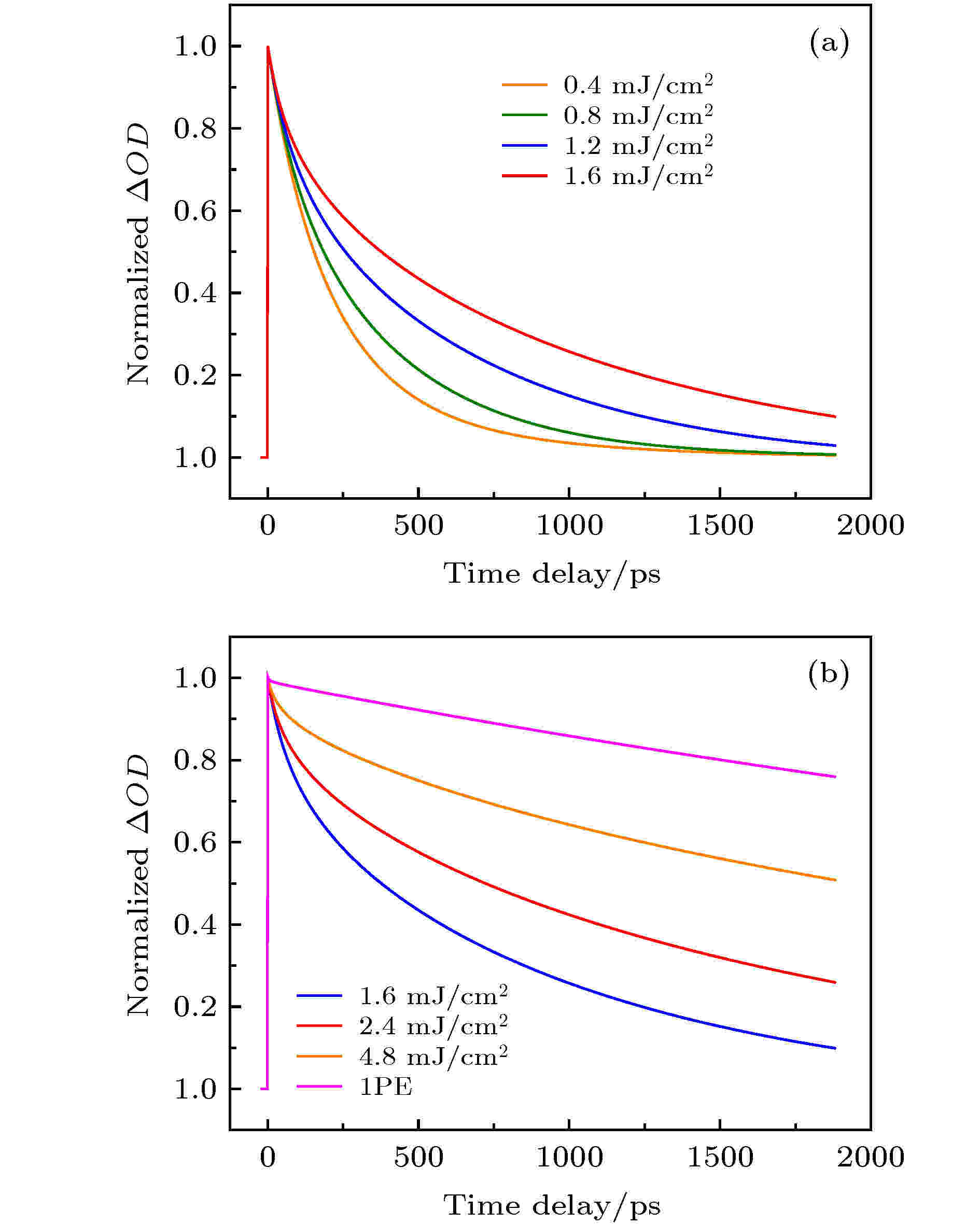 图 5 利用载流子复合模型拟合和模拟不同激发能流下GaN: Ge的超快载流子弛豫动力学 (a)实验结果拟合; (b)更大的激发能流和1PE情况
图 5 利用载流子复合模型拟合和模拟不同激发能流下GaN: Ge的超快载流子弛豫动力学 (a)实验结果拟合; (b)更大的激发能流和1PE情况Figure5. Fitting and simulation of ultrafast carrier relaxation dynamics in GaN: Ge using carrier recombination model: (a) The fitting of experimental results; (b) under higher excitation fluence and 1PE.
载流子寿命是光子器件的关键, 而根据(5)式以及载流子动力学实验和模拟结果可知: 1)在高载流子注入下(>1018 cm–3), n型GaN的载流子寿命主要由位错密度和辐射复合决定; 2)在适中的载流子注入下(1016—1017 cm–3), 辐射缺陷、非辐射复合缺陷以及固有载流子浓度将会共同决定载流子的寿命. 图6显示了在1PE和2PE下GaN: Ge在通讯波段1310 nm探测下的超快瞬态吸收响应. 和我们分析的一致, 1PE下的载流子寿命(约10 ns)远远大于2PE下的载流子寿命. 根据参考文献[41], 可估算出1PE下GaN:Ge的发光内量子效率约50%. 2PE下内量子效率虽然严重下降, 但更快的载流子寿命反而有利于其应用于超快全光开关器件.
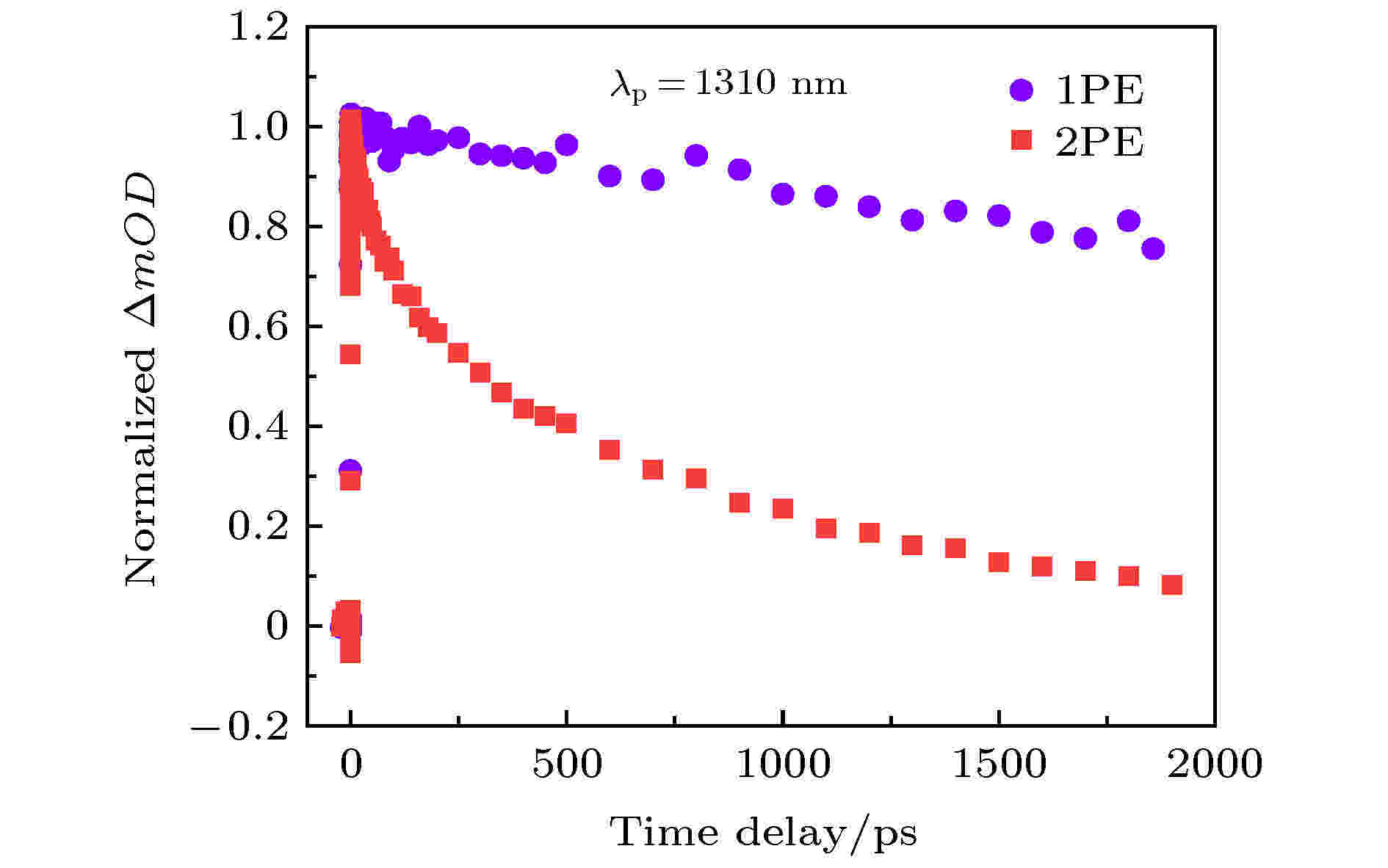 图 6 1PE(0.8 mJ/cm2)和2PE(1.6 mJ/cm2)下GaN:Ge在通讯波段1310 nm下的超快瞬态吸收动力学
图 6 1PE(0.8 mJ/cm2)和2PE(1.6 mJ/cm2)下GaN:Ge在通讯波段1310 nm下的超快瞬态吸收动力学Figure6. Ultrafast transient absorption kinetics in GaN:Ge probed at communication band 1310 nm under both 1PE (0.8 mJ/cm2) and 2PE (1.6 mJ/cm2).
